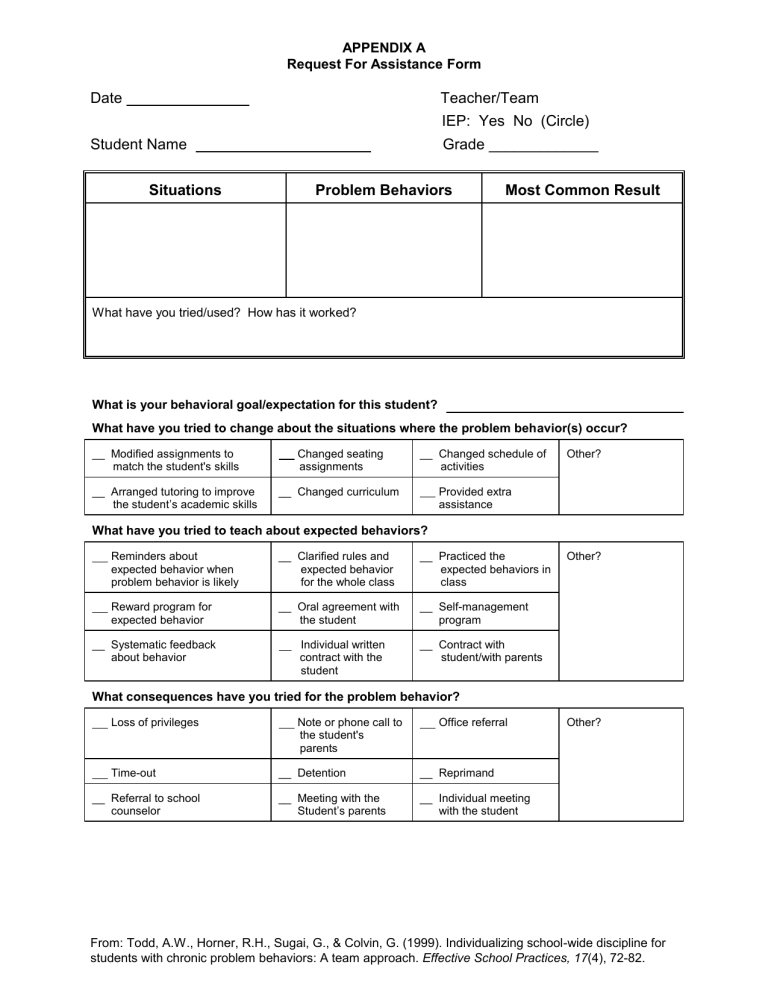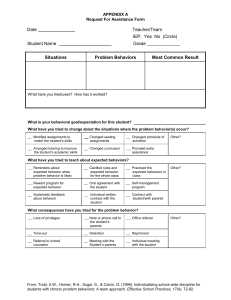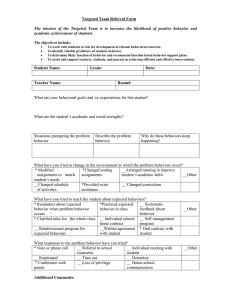
APPENDIX A Request For Assistance Form Date Teacher/Team IEP: Yes No (Circle) Student Name Situations Grade _____________ Problem Behaviors Most Common Result What have you tried/used? How has it worked? What is your behavioral goal/expectation for this student? What have you tried to change about the situations where the problem behavior(s) occur? __ Modified assignments to match the student's skills __ Arranged tutoring to improve the student’s academic skills Changed seating assignments __ Changed schedule of activities __ Changed curriculum Other? Provided extra assistance What have you tried to teach about expected behaviors? Reminders about expected behavior when problem behavior is likely __ Clarified rules and expected behavior for the whole class __ Practiced the expected behaviors in class Reward program for expected behavior __ Oral agreement with the student __ Self-management program __ Systematic feedback about behavior Individual written contract with the student Other? __ Contract with student/with parents What consequences have you tried for the problem behavior? Loss of privileges Time-out __ Referral to school counselor Note or phone call to the student's parents Office referral __ Detention __ Reprimand __ Meeting with the Student’s parents __ Individual meeting with the student Other? From: Todd, A.W., Horner, R.H., Sugai, G., & Colvin, G. (1999). Individualizing school-wide discipline for students with chronic problem behaviors: A team approach. Effective School Practices, 17(4), 72-82. APPENDIX A. Request for Assistance Form (page 2 of 2) WHEN ADDRESSING THIS PROBLEM, PLEASE CONSIDER THE FOLLOWING QUESTIONS: 1. When is the problem behavior(s) most and least likely to occur? On particular days of the week (e.g., Monday) or times of day (e.g., right after recess)? During or after interactions with certain people e.g., during small, cooperative group projects? During certain types of activity or tasks, e.g., during apparently difficult or boring work? In connection with particular features of the physical environment e.g., noisy, crowded? Features of routine e.g., when there are unexpected changes or when a preferred activity is canceled? Medical or physical factors e.g., apparent hunger or lack of sleep? Other influences? 2. What do you think the student(s) may gain from the problem behaviors? Attention? What kind of attention? From whom? Avoid an apparently difficult or boring activity? Avoid teacher interaction? Get control of a situation? Avoid embarrassment in front of peers? Summary of Behavior Setting Events & Predictors Behaviors of Concern Maintaining Consequences 3. Are there appropriate behaviors that the student could use that would make the problem behavior unnecessary? 4. Teacher Support Team Decision Q Some suggestions regarding interventions to try. Q Referral to a different team for assessment (speech hearing, academic): _________________________ Q Formation of an Action Team to conduct a Functional Assessment and develop a plan of support. 5. Date for Follow Up From: Todd, A.W., Horner, R.H., Sugai, G., & Colvin, G. (1999). Individualizing school-wide discipline for students with chronic problem behaviors: A team approach. Effective School Practices, 17(4), 72-82.


